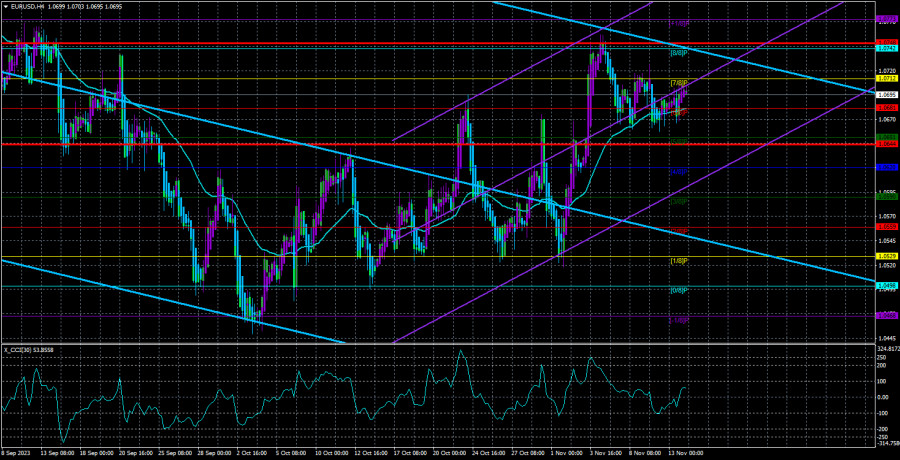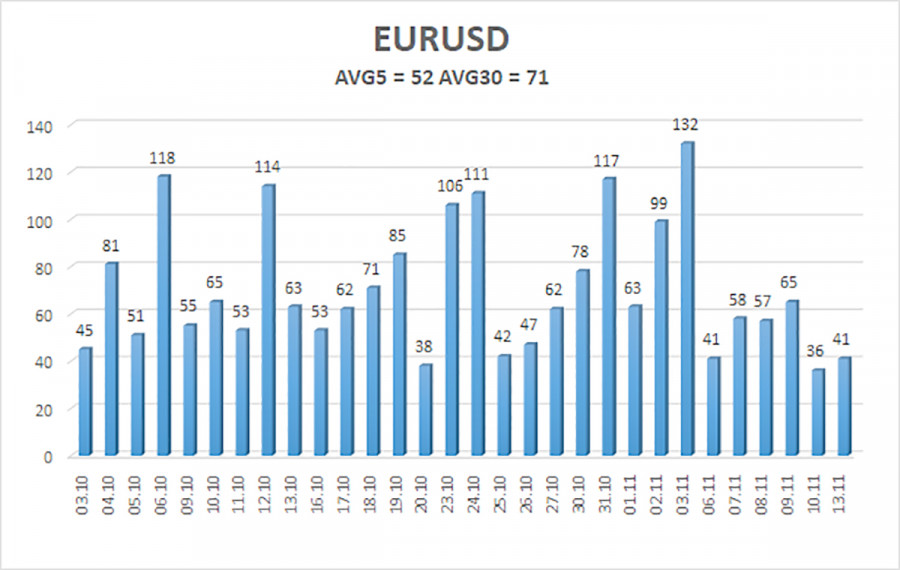

The currency pair EUR/USD on Tuesday essentially continued to stand still. The day's volatility was 41 points, so there is not much to discuss. In the 4-hour timeframe, due to low volatility in the last month and a half, the scale has increased, creating the impression that the pair is trading quite actively. This is not the case. It is just a visualization of movements by the terminal. Therefore, at the moment, the downward movement is still too weak to talk about a resumption of the downtrend. So far, the price has not been able to overcome even the moving average and has been flat for a week. Therefore, we still expect the pair to fall, but there are no specific reasons or trading signals to believe so.
Regarding the continuation of the upward correction, we don't necessarily disbelieve or see the factors that could drive the European currency higher. Recall that it corrected by 300 points over the past month and a half with the help of less-than-favorable American statistics. We would not have seen such a correction if it weren't for the disappointing reports from across the ocean. As for the background of the European Union, it is currently very difficult to find anything positive. Macroeconomic statistics are weak, the economy is not growing, and the ECB key rate is not rising. Only inflation is falling at more or less decent rates, which is more bad than good for the euro. The likelihood of additional tightening of monetary policy is decreasing even further.
Therefore, at the moment, we can rely on "technicals" and rare macroeconomic reports. All statements from ECB and Fed representatives do not provide any fundamentally new information to traders. No one in the Fed or ECB can say what the data will be like in a month or two. Both central banks have taken a wait-and-see position and will only intervene in the case of such circumstances.
Boris Vujcic is full of optimism. The head of the Croatian central bank and a member of the ECB's monetary committee, Boris Vujcic, stated that the regulator could achieve a "soft" landing for the economy. This news sounds optimistic for the European currency, but there is a small problem. The market is unlikely to react to it with new euro purchases. What does "soft landing" mean in practice? Only that the European currency will not collapse into a recession against tightening monetary policy. The fact that there will be no recession in the European Union is good, but most likely, there will be no recession in the United States. Therefore, the euro and the dollar are on equal footing. The difference is that the American economy continues to grow by 2-5% every quarter, while the European economy has remained for about five quarters.
Mr. Vujcic also stated there is no certainty in the "soft landing"; it is only possible if the ECB's forecasts come true. "We must be prepared for any possible developments. We must be prepared to raise or lower the rate based on incoming data," Vujcic believes. As we have already mentioned, ECB and Fed representatives should be providing more important information now. The market has already memorized the phrase "We will raise the rate if the situation requires it," and representatives of both central banks repeat this phrase from time to time. Officials cannot provide anything else now, but it doesn't make the situation any easier. We see how volatility has dropped over the past couple of months. This means the market is still being determined and tries to trade minimally. In general, the situation in the market could be better at the moment.

The average volatility of the euro/dollar currency pair over the past five trading days as of November 14 is 52 points and is characterized as "weak." Thus, we expect the pair to move between the levels of 1.0644 and 1.0748 on Tuesday. A downward reversal of the Heiken Ashi indicator will indicate a new attempt to resume the downtrend.
Nearby support levels:
S1 – 1.0681
S2 – 1.0651
S3 – 1.0620
Nearby resistance levels:
R1 – 1.0712
R2 – 1.0742
R3 – 1.0773
Trading recommendations:
The EUR/USD pair continues to change direction almost every day. Therefore, relying on the moving average is a futile endeavor. The corrective trend persists, as the price cannot surpass the moving average. So, first, we observed the daily overcoming of the moving average line, and now – a total flat. We need to wait. Wait for good signals, a strong background, and an intensification of pair movements.
Explanations for the illustrations:
Linear regression channels – help determine the current trend. If both are directed in the same direction, the trend is strong.
The moving average line (settings 20,0, smoothed) – determines the short-term trend and the direction in which trading should be conducted.
Murray levels – target levels for movements and corrections.
Volatility levels (red lines) – the probable price channel in which the pair will spend the next day, based on current volatility indicators.
CCI indicator – its entry into the oversold area (below -250) or overbought area (above +250) indicates that a trend reversal is approaching in the opposite direction.